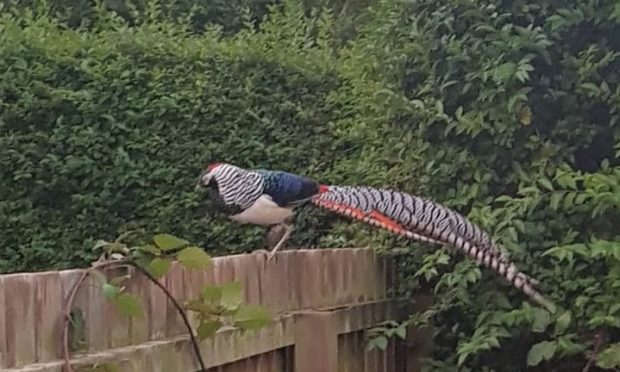An exotic game bird, extinct in the wild in the UK, has gone on the run in Fife.
The Lady Amherst’s pheasant, caught on camera visiting a garden in St Andrews, is believed to have escaped from captivity.
Resident Bruce Herschell was stunned to find the bird, with its impressive black and white plumage, red crest and long ornate tail, in his back garden in Langlands Road.
He said: “I was just in the kitchen looking out at my garden when I saw it and thought ‘wow, what’s that?’
“I looked at it for a few seconds and quickly popped out with a camera, my phone, and quickly got a snap of the thing.
“At first I thought it was a peacock but when it started to move around, it moved like a pheasant.
“I’ve had a couple of pheasants in the garden but just the normal brown variety.”
He added: “If it’s an escapee then obviously somebody will be missing it.”
Introduced to the Bedfordshire area by the Victorians in the 1890s, Lady Amherst’s pheasants are native to south-western China and neighbouring regions of Burma.
It is thought there were around 50 of the birds in the county in the late 1980s, according to a paper on the species by a member of the Bedfordshire Bird Club.
However, by 1990, numbers had fallen to around 20 and continued to decline.
What is believed to have been the UK’s last ever Lady Amherst’s pheasant lived in woodland in Millbrook, near Bedford, and was photographed in 2015.
However, as a result of Mr Herschell sharing a post about his discovery on Facebook, someone has since come forward to say he photographed a Lady Amherst’s pheasant in 2016 and believes this to be the last picture of the remaining wild bird.
The British Trust for Ornithology (BTO) said the pheasant seen in
St Andrews was unlikely to be a remnant from the Bedfordshire population.
A spokesman for the BTO said: “This bird will be an escapee from somewhere nearby. Like all pheasants, Lady Amherst’s pheasant isn’t a great flyer.”










